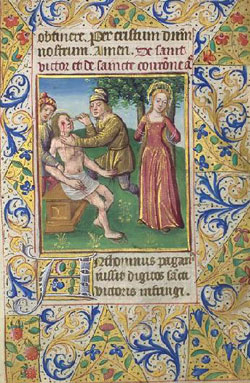
Feastday: May 14
Patron: of Feltre; Castelfidardo; Corona is invoked in connection with superstitions involving money, such as gambling or treasure hunting
Death: 176
Little is known about the two Christian martyrs, St. Victor and St. Corona. Most sources believe they were killed near each other in Roman Syria during the reign of Marcus Aurelius in 170 A.D. and that a Roman judge named Sebastian ordered for their deaths.
Victor was believed to be a Roman soldier. After his Christianity was discovered, other soldiers brought Victor to face judgement before Sebastian. Sebastian was known for being a tough man who despised Christians.
Sebastian, wanting to make an example out of Victor, ordered to be bound to a pillar and whipped until his skin fell from his body. After the whipping, Sebastian ordered Victor's eyes to be gouged out.
No matter the amount of pain Victor endured, he never denied the Lord.
News about Victor's cruel treatment reached a young girl named Corona. Corona is believed to have been the wife of one of the soldiers, and a Christian herself, though she kept her faith a secret.
Hearing about Victor, Corona decided she needed to do something to help the dying man. She publicly announced her own Christianity and rushed to Victor's side. She knelt next to him and prayed, letting him know he was not alone.
Not much time passed before Corona was brought before Sebastian, too, to face her own punishment.
Sebastian could not believe Corona's actions. He immediately ordered her to be imprisoned and tortured. Corona was tied to the tops of two palm trees bent down to the ground.
At Sebastian's command, the ropes holding the trees down were cut and the trees sprang away from each other and back to their upright position. The force was so strong that Corona's body was ripped in half.
As a final command, Sebastian ordered Victor to be beheaded.
The stories surrounding St. Victor and Corona vary with some even considering the two martyrs were actually husband and wife killed alongside each other for their faith.
Remains, believed to be of St. Victor and Corona's, have been in a basilica in the city of Anzů, Italy since the 9th century.
St. Corona is the patron saint of treasure hunters, and St. Victor and Corona's feast day is celebrated on May 14.
2nd-century Christian martyrsSaints Victor and Corona are two Christian martyrs. Victor was a Roman soldier who was tortured and killed; Corona was killed for comforting him.
Legend

 St Victor of Siena (left) and St Corona by the Master of the Palazzo Venezia Madonna in the National Gallery of Denmark.
St Victor of Siena (left) and St Corona by the Master of the Palazzo Venezia Madonna in the National Gallery of Denmark.
Their legend states that Victor was a Roman soldier of Italian ancestry, who was tortured, including having his eyes gouged out, and was beheaded. Most sources state that he and Corona were killed in Roman Syria during the reign of Marcus Aurelius (around the 160s-170s AD), but various hagiographical texts disagree about the site of their martyrdom, with some stating that it was Damascus, while Coptic sources state that it was Antioch. Some Western sources state that Alexandria or Sicily was their place of martyrdom. They also disagree about the date of their martyrdom. They may have been martyred during the reign of Antoninus Pius, or Diocletian, while the Roman Martyrology states that it was in the third century when they met their death.
While he was suffering from the tortures, the sixteen-year-old wife of another soldier, named Corona or Stephanie (or Stefania or Stephana, from Greek στέφᾰνος, stéphanos, "crown", the Greek version of her Latin name, which also means "crown") comforted and encouraged him. For this, she was arrested and interrogated. According to the passio of Corona, Corona was bound to two bent palm trees and torn apart as the trunks were released; the passio is considered largely fictional, and she herself may also be fictional. Other sources state that Victor and Corona were husband and wife.
There is also debate as to where Corona was from; differing accounts place her in Syria, Sicily, and Marseille.
Veneration
Victor and Corona's memorial day is 24 November (11 November in the Orthodox church calendar). Their feast day is 14 May. Outside the town of Feltre in northern Italy, on the slopes of Mount Miesna, is the church of SS. Vittore e Corona, erected by the Crusaders from Feltre after the First Crusade.
Corona is especially venerated in Austria and eastern Bavaria. There is a chapel dedicated to her in Sauerlach, near Munich. There are two churches named after her in the Roman Catholic Diocese of Passau and two towns named after her in Lower Austria. A statue of her stands in the Münster Cathedral.
Around 1000 AD Otto III, Holy Roman Emperor brought Corona's relics to Aachen in western Germany. Her relics were rediscovered during excavation work at Aachen Cathedral in 1910. The relics were removed from a crypt and placed in a shrine inside the cathedral.
Corona is the patroness of causes involving money, such as gambling and treasure hunting, a result of a later treasure hunter who credited his success to invoking her. She is called upon by a treasure hunter to bring treasure, and then sent away through a similarly elaborate ritual. She was not historically a patron saint of or invoked against pandemics or disease, but has been invoked against the COVID-19 pandemic. Her relics will be available for public veneration once the pandemic has passed.





